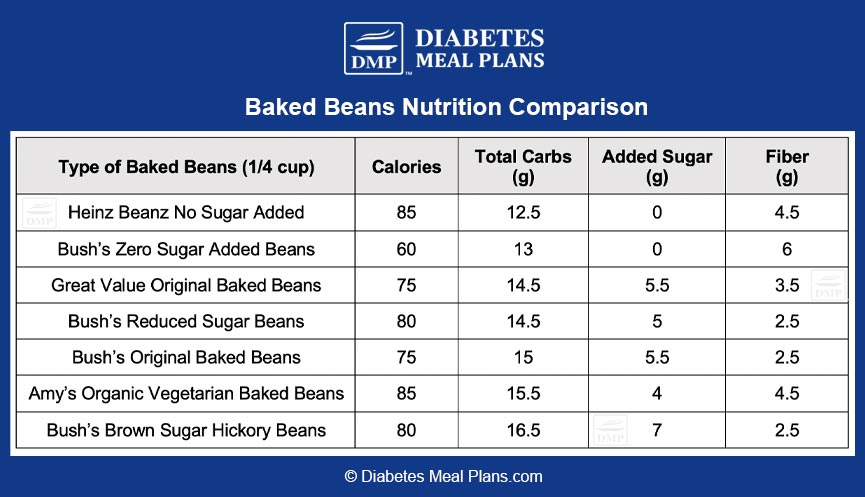Baked beans have been a huge hit since the very first can was created at the Heinz factory in Pittsburg, Pennsylvania over 120 years ago.
We still enjoy baked beans today as a side dish for dinner, as a part of a summer BBQ, or even for breakfast in some regions!
So, are baked beans a suitable option for people with type 2 diabetes and prediabetes? The short answer is YES, but you do need to consider portions.
Let’s take a closer look.
Baked Beans Nutrition Facts
These days there are so many varieties of baked beans available for purchase.
Honey-glazed, hickory-smoked, rich and spicy goodness…do any of these pre-packaged wonders fit into a low carb diet?
Well, it depends on the ingredients.
A generic recipe of baked beans will start with white beans in a tomato-based sauce. Herbs, spices, and sweeteners will then be added to taste.
Some baked beans contain meat like ham or bacon, while other varieties are vegetarian.
To keep things simple, we’ll start by looking at the nutrition for a no-nonsense can of unsweetened baked beans.
Bush’s Zero Sugar Added Baked Beans – a quarter cup serving (65g):
- Calories: 60
- Total Carbs: 13g
- Fiber: 6g
- Protein: 3.5g
- Fat: 0.3g
You may have noticed the small serving size of just a quarter cup; that’s no mistake!
While a standard serving size of most baked beans is half a cup, we recommend an even smaller portion for people with diabetes. A maximum of a quarter cup or quarter can will keep your blood sugar levels in check.
With that serving size you get 6g of fiber, which is great for blood sugar regulation and digestion, but that still doesn’t “zero out” the 13g of carbs from the white beans and tomato sauce. You still need to be mindful of portion size.
You want to be careful when buying canned baked beans, and look out for labels that advertise a sweet flavor, advertising with words like “honey” “maple” “brown sugar,” and “sweet and hot.”
These are pretty easy to spot right off the bat, but most “original” baked beans also have added sugar, so be mindful of that too.
If the branding doesn’t immediately give it away, flip the can over and check out the ingredients list and nutrition label and take note of the nutrition facts label – this is where to find the information that matters. Choose baked beans that are lower in carbs.
Comparing Canned Baked Beans
Now, let’s see those differences in action by comparing a variety of sugarless and sweetened baked beans.
These are all similar in fat and protein, so let’s focus our attention on the total carbs and added sugar columns.

Look at the difference in added sugars between the zero sugar added options and the super-sweet brown sugar hickory baked beans – an extra 4g carbs for the same portion size.
The low-to-no sugar options are just as filling and can taste just as great as the sugary ones do. Once you switch to lower sugar options for a while, you’ll barely even miss the over-the-top sweetness that you used to crave.
If you still want that sweet flavor without all the extra carbs, you may want to try your hand at making a batch of baked beans at home.
Recommendations for Baked Beans & Diabetes
So, can you enjoy baked beans with your diabetes diet and still maintain good blood sugar control?
Yes, you sure can!
Here’s a summary of guidelines:
- Be wise about portion size: try not to exceed a quarter of a cup/can per sitting. It’s easy to go overboard with carbs when you start increasing your serving size or start eating moderate-carb foods like beans too many times per week. Don’t indulge too often, save foods like beans and legumes for just a few times a week at maximum.
- Select a “no sugar added” option: the best baked beans for diabetes contain low or no added sugar. Steer clear of those sweetened with sugar, honey, or molasses.
- Choose baked beans that are lower in total carbohydrates: Carbohydrates are the nutrient that has the greatest influence on blood sugar and A1c levels, so choosing the right carbs and eating the right amounts are the most important aspects of your type 2 diabetes or prediabetes treatment.

Baked Beans FAQ
Can diabetics eat bush’s baked beans?
Yes. But, Bush’s have a wide variety of baked beans. Bush’s no added sugar baked beans contains 13g carbs per quarter cup, while Bush’s Brown Sugar Hickory Beans contain 16.5g carbs per quarter cup.
The best Bush’s baked bean options to choose are the zero sugar or reduced sugar, and still stick to our recommended guidelines of a portion size of no more than a quarter of a cup per sitting.

Can diabetics eat vegetarian baked beans?
Yes. Majority of baked beans are vegetarian. It’s only when they add flavors like bacon or ham that this may be different. Just keep in mind that with all baked beans, the recommendation is to choose baked beans lower in carbs and limit portions to about a quarter can per serve.
What’s the recommended serving size of baked beans for diabetics?
The amount we recommend for people with type 2 diabetes and prediabetes – as experienced nutritionists – is a maximum of a quarter cup or quarter can of baked beans per serve. This will still provide a satisfying portion without compromising good blood sugar control.

Brenda
What about the potassium level?
Dr Jedha
Hi Brenda, The approximate potassium content in ¼ cup (about 60g) of baked beans is around 150–200 mg, but may vary depending on the brand and preparation method.